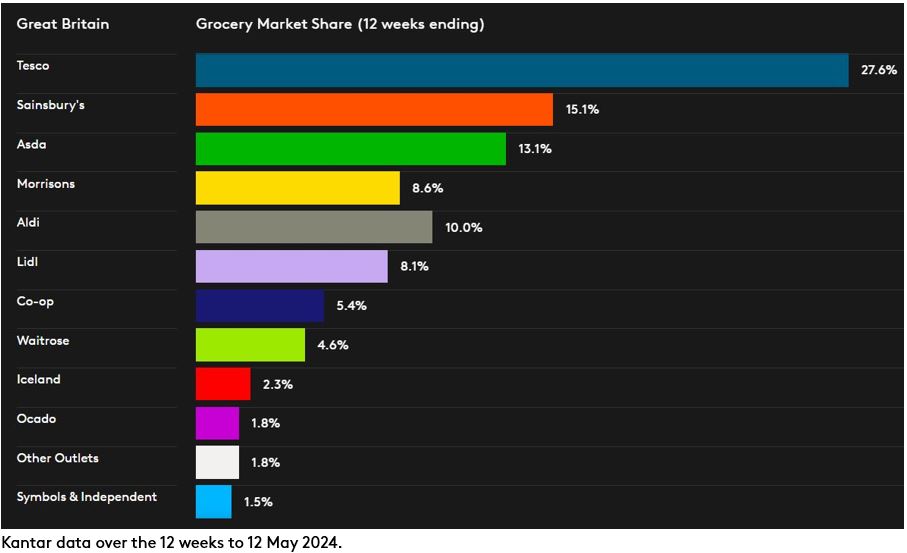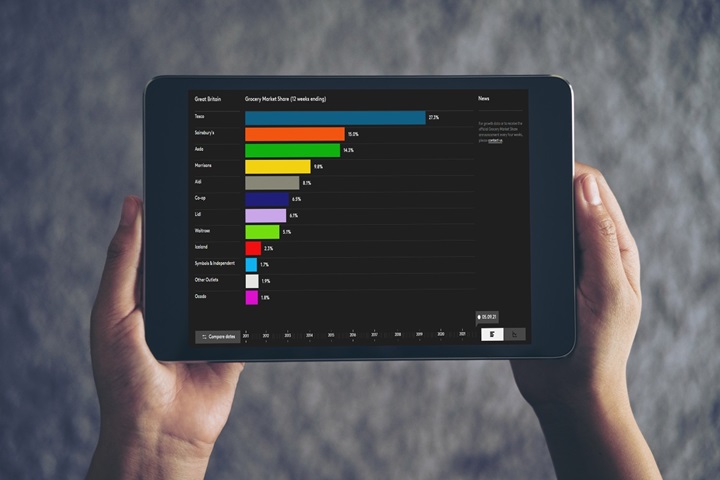Take-home grocery sales rose by 2.9% over the four weeks to 12 May, according to our latest figures. Grocery price inflation has also fallen for the fifteenth month in a row to 2.4%, the lowest level since October 2021.
Grocery price inflation is gradually returning to what we would consider more normal levels. It’s now sitting only 0.8 percentage points higher than the 10-year average of 1.6% between 2012 and 2021, which is just before prices began to climb.
Typically, an inflation rate of around 3% is when we start to see marked changes in consumers’ behaviour, with shoppers trading down to cheaper items when the rate goes above this line and vice versa when the rate drops. However, after nearly two and a half years of rapidly rising prices, it could take a bit longer for shoppers to unwind the habits they have learnt to help them manage the cost of living crisis. Own-label lines are proving resilient, for example, and they are still growing faster than brands, making up over half (52%) of total spending. Sales of premium own label ranges continue to increase too, up by 9.9% compared with a year ago.
First signs of the sun, high hopes for summer of sport
While pressures remain on household budgets, shoppers took the opportunity to enjoy the long weekend on 4-6 May. It seems that many barbecues were given their first outings of the year during the most recent bank holiday weekend. Burger sales climbed by 13%, while beer and wine sales shot up by 9% and 21% respectively versus the Friday, Saturday and Sunday of the week before.
With the 2024 UEFA European men’s football tournament and the Olympic Games on the horizon, the summer months could see sales increases for the retailers. Major sporting events can have a big impact on grocery sales, particularly in categories like alcohol. During England’s quarter final match against France in the 2022 FIFA Men’s World Cup, take-home beer sales hit their biggest daily takings of the year outside of Christmas. Especially if it’s paired with warmer temperatures, this year’s summer of sport could deliver a welcome boost for the sector.
Ocado leads retailer pack, new share high for Lidl
Ocado was again the fastest growing grocer over the 12 weeks to 12 May, with sales up by 12.4% - well ahead of the total online market, which saw sales increase by 5.4%. The online-only retailer accounts for 1.8% of the grocery market, though this figure rises to 3% in London. Outside of the capital, Ocado saw its strongest growth in the south and east of England where one in twenty households shopped at the retailer in the latest 12 weeks.
Lidl reached a new record-high market share of 8.1%, fuelled in part by its bakery counters, as well as its loyalty scheme. Freshly baked bread, cake or pastry made it into a quarter of baskets at the discounter over the latest 12 weeks, and coupons through the Lidl Plus app helped pushed volume sales of in-store bakery items up by over 40%.
Britain’s biggest grocer Tesco now takes 27.6% of the market - an increase of 0.5 percentage points since last year, marking its largest annual share gain since January 2022. Its 5.6% growth in sales was matched by Sainsbury’s, whose market share nudged up 0.3 percentage points to 15.1%. Asda, meanwhile, holds 13.1% of the grocery market, while Aldi and Morrisons captured 10.0% and 8.6% respectively.
Convenience specialist Co-op’s share of the market is now 5.4%. Both Waitrose and Iceland held market share steady, with the former remaining flat at 4.6% and the latter at 2.3%.



